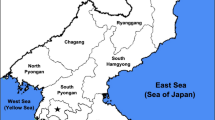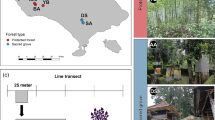Abstract
The paper attempts to measure forest dependence index of tribes based on forest product collection for livelihood generation and how social security programmes have impacted on forest dependence index. Besides, the paper tries to identify the factors influencing forest dependency and its implication for tribal livelihood. The present paper is based on primary data collected from the Purulia forest division in the district of Purulia, one of the tribal-dominated districts of West Bengal during 2019 across tribal communities of Santal, Munda, Bhumij and Lodha. The results of the study showed that forest dependence index of Purulia district is found to be 0.42. Bhumij tribes are highly forest dependent than others. The forest dependency has been negatively influenced by social security programmes implies that the getting proper benefits of social security programmes has led to low forest dependence of the tribal community of Purulia district. The forest dependency also explained by family size, age of headed household, education, distance from market and land holdings.
Similar content being viewed by others
Data availability
Field survey.
Code availability
Not applicable.
Change history
25 August 2022
A Correction to this paper has been published: https://doi.org/10.1007/s43545-022-00469-7
References
Abbas S, Kousar S (2021) Spatial analysis of drought severity and magnitude using the standardized precipitation index and stream flow drought index over the Upper Indus Basin, Pakistan. Environ, Dev Sustain 23:15314–15340. https://doi.org/10.1007/s10668-021-01299-y Accessed 25 January 2021.
Abbas S, Khan K, Khan AA (2016) Redd plus and their impact on green economy development: implication for sustainable forest development, Swat Valley, Hkh Region Khyber Pakhtunkhwa. Pak Sci Int (lahore) 28(5):46457–54664
Adam YO, Abdalla M, Tayeb EL (2014) Forest dependency and its effect on conservation in Sudan: a case of Sarf-Saaid reserved forest in Gadarif state. Agric For 60(3):107–121
Adhikari B (2005) Poverty, property rights, and collective action: understanding the distributive aspects of common property resource management. Environ Dev Econ 10(1):7–31
Angelsen A, Wunder S (2003) Exploring the forest-poverty link: key concepts, issues and research implications. Economist 40:68
Angelsen A, Jagger P, Babigumira R, Belcher B, Hogarth NJ, Bauch S, Wunder S (2014) Environmental income and rural livelihoods: a global comparative analysis. World Dev 64(S1):S12–S28
Arnold JEM, and Bird P (1999) Forest and the poverty-Environment Nexus, Paper presented at the UNDP-EC Expert workshop on poverty and the environment, Brussels, Belgium.
Ayers JM, Huq S, Faisal AM, Hussain ST (2014) Mainstreaming climate change adaptation into development: A case study of Bangladesh. Wiley Interdiscip Rev 5(1):37–51
Bahuguna VK (2000) Forests in the economy of the rural poor: an stimation of the dependency level. AMBIO: J Hum Environ 29(3):126–129
Bandyopadhyay GS (2012) “Development versus displacement—growing marginalization among the folktribal peoples of globalized India.” Conference proceedings of international conference on arts, social sciences and technology (iCAST), MIT, Penang, Malaysia.
Barham BL, Coomes OT, Takasaki Y (1999) Rain forest livelihoods: income generation, household wealth and forest use. Unasylva 50(198):34–42
Bhowmick P K (1985) Tribal situation in West Bengal, Indian Anthropologist 15(1): 1–19, https://www.jstor.org/stable/41919502 Accessed 14 January 2021.
Campbell B, Luckert M (2002) Uncovering the hidden harvest: valuation methods for woodland and forest resources: London. VA Earth scan Publications, Sterling
Cavendish W (2000) Empirical regularities in the poverty-environment relationship of rural households: evidence from Zimbabwe. World Dev 28(11):1979–2003
Cavendish W (1999) Poverty, inequality and environmental resources: quantitative analysis of rural households. Working Paper Series 99–9, Centre for the Study of African Economies, Oxford.
Census of India (2011) Archived from https://censusindia.gov.in/2011-common/censusdata2011.html Accessed 8 January 2021.
Chendrasekhar E (1954) Hungry people and empty land, Allen and Unwin Ltd, London. https://books.google.co.in/books?id=EEkuAAAAMAAJ&redir_esc=y Accessed 2 February 2021.
Das SK (2017) Nexus between common property resources and social protection programs for tribal food security. Int J Recent Sci Res 8(5): 17901–17905, https://www.recentscientific.com/sites/default/files/7874-A-2017.pdf Accessed 29 January 2021.
Das SK, Sen RK (2019) Role of social protection policies to remove inequality and poverty in three tribal districts of West Bengal. In: De UK, Pal M (eds) Development and deprivation in the Indian sub-continent. Routledge, London. https://doi.org/10.4324/9780429331756 Accessed 3 February 2021.
Das SK (2020) Impact of social protection programmes and common property resources for the food security of tribes in the backward regions of West Bengal. Vidyasagar University. http://inet.vidyasagar.ac.in:8080/jspui/bitstream/123456789/5600/14/14_chapter5.pdf.pdf Accessed 2 February 2021.
Ferrari S, Cribari-Neto F (2004) Beta regression for modelling rates and proportions. J Appl Stat 31(7):799–815. https://doi.org/10.1080/0266476042000214501 Accessed 24 February 2021.
Ghosal S (2011) Importance of non-timber forest products in native household economy. J Geogr Reg Plan 4(3):159–168
Hedge R, Enters T (2000) Forest products and household economy: a case study from Mudumalai wildlife sanctuary, southern India. Environ Conserv 27:250–259. https://doi.org/10.1017/S037689290000028X Accessed 24 February 2021.
Hoffman CL (1984) Punan foragers m the trailing networks of southeast Asia. In: Shnre C (ed) Past and present m hunter gatherer studzes. Academic Press, New York
IPBES (2019) Nature’s dangerous decline- unprecedented species extinction rates accelerating. France, Paris
Lauren N, Rhemtulla JM, Zerriffi H (2020) Forest dependence is more than forest income: development of a new index of forest product collection and livelihood resources. World Dev 125: 1-13,104689
Lemos MC, Boyd E, Tompkins EL, Osbahr H, and Liverman D (2007) Develo** adaptation and adapting development. Ecol Soc 12(2), 26. http://www.ecologyandsociety.org/vol12/iss2/art26/ES-2007-2133.pdf Accessed 24 February 2021
Malhotra KC, and Bhattacharya P (2010) Forest and Livelihood. CESS Publisher, Hyderabad, India, Pages: 246. https://scialert.net/abstract/?doi=rjf.2016.1.7 Accessed 12 April 2021
Mukul SA, Rashid AZMM, Uddin MB, Khan NA (2016) Role of non-timber forest products in sustaining forest-based livelihoods and rural households’ resilience capacity in and around protected area: a Bangladesh study. J Environ Plan Manag 59(4):628–642
Newton P, Miller DC, Byenkya MAA, Agrawal A (2016) Who are forest dependent people? A taxonomy to aid livelihood and land use decision-making in forested regions. Land Use Policy 57:388–395
Pandey AK, Kori DC (2011) Non-destructive harvesting practices of Terminaliaarjuna (Arjuna), Phyllanthusemblica (Aonla) and Andrographispaniculata (Kalmegh). Indian For 137:1269–1279
Pandey AK, Tripathi YC, and Kumar A (2016) Non timber forest products (NTFPs) for sustained livelihood: challenges and strategies, Res J For 10(1): 1–7 https://scialert.net/abstract/?doi=rjf.2016.1.7 Accessed 15 March 2021
Paumgarten F (2005) The role of non-timber forest products as safety nets: a review of evidence with a focus on South Africa. GeoJournal 64(3):189–197
Reddy SRC, Chakravarty SP (1999) Forest dependence and income distribution in a subsistence economy: evidence from India. World Dev 27(7):1141–1149. https://doi.org/10.1016/S0305-750X(99)00057-1 Accessed 17 March 2021
Rustein, S. O., 2008. The DHS wealth index: approaches for rural and urban areas. Demographic and Health Research 60. Macro International Inc. USA
Shackleton C, Shackleton S (2004) The importance of non-timber forest products in rural livelihood security and as safety nets: a review of evidence from South Africa. S Afr J Sci 100(11):658–664
Shackleton CM, Shackleton SE, Buiten E, Bird N (2007) The importance of dry woodlands and forests in rural livelihoods and poverty alleviation in South Africa. For Policy Econ 9(5):558–577
Shackleton S, Delang CD, Angelson A (2011) Non-timber forest products in global context. Non-Timber For Prod Glob Context 7:55–81
Shackleton CM, Pandey AK, Ticktin T (2015) Ecological sustainability for non-timber forest products: dynamics and case studies of harvesting. Routledge, New York, USA
Sushant (2013) Impact of climate change in eastern Madhya Pradesh, India. Trop Conserv Sci 6(3):338–364. https://doi.org/10.1177/194008291300600304 Accessed 21 March 2021.
Timko JA, Waeber PO, Kozak RA (2010) The socio-economic contribution of non-timber forest products to rural livelihoods in Sub-Saharan Africa: knowledge gaps and new direction. Int for Rev 12(3):284–294
Troisi J (1979) Tribal Religion. Religious beliefs and practices among the Santals. Columbia: South Asia Books. https://www.worldcat.org/title/tribal-religion-religious-beliefs-and-practices-among-the-santals/oclc/5515973 Accessed 29 March 2021.
United Nations Development Project (2006). Human development report 2006. http://hdr.undp.org/en/reports/global/hdr2006/chapters/ Accessed 19 January 2021.
Wunder S, Angelsen A, Belcher B (2014) Forests, livelihoods and conservation: broadening the empirical base. World Dev 64(S1):S1–S11
Funding
No funding was received for the preparation of this manuscript.
Author information
Authors and Affiliations
Contributions
The author has contributed to the conception and design of the study. Material preparation, data collection and analyses were performed by Dr. SKD. The final draft of the manuscript was written by Dr. SKD.
Corresponding author
Ethics declarations
Conflict of interest
The author has no relevant financial or non-financial interests to disclose. The author has no conflict of interest to declare that is relevant to the content of this article.
Ethical approval
This article does not contain any studies with animals performed by any of the author.
Consent to participate
Yes.
Consent for publication
Yes.
Rights and permissions
Springer Nature or its licensor holds exclusive rights to this article under a publishing agreement with the author(s) or other rightsholder(s); author self-archiving of the accepted manuscript version of this article is solely governed by the terms of such publishing agreement and applicable law.
About this article
Cite this article
Das, S.K. Forest dependency, social protection and tribal livelihood an empirical study in the backward district of Purulia, West Bengal. SN Soc Sci 2, 130 (2022). https://doi.org/10.1007/s43545-022-00431-7
Received:
Accepted:
Published:
DOI: https://doi.org/10.1007/s43545-022-00431-7







